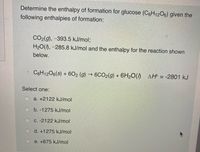
Chemistry
10th Edition
ISBN: 9781305957404
Author: Steven S. Zumdahl, Susan A. Zumdahl, Donald J. DeCoste
Publisher: Cengage Learning
expand_more
expand_more
format_list_bulleted
Concept explainers
Question

Transcribed Image Text:Determine the enthalpy of formation for glucose (C6H1206) given the
following enthalpies of formation:
CO2(g), -393.5 kJ/mol;
H20(), -285.8 kJ/mol and the enthalpy for the reaction shown
below.
C6H1206(s) + 6O2 (g) → 6CO2(g) + 6H2O() AH = -2801 kJ
Select one:
a. +2122 kJ/mol
b. -1275 kJ/mol
C. -2122 kJ/mol
d. +1275 kJ/mol
e. +875 kJ/mol
Expert Solution
This question has been solved!
Explore an expertly crafted, step-by-step solution for a thorough understanding of key concepts.
This is a popular solution
Trending nowThis is a popular solution!
Step by stepSolved in 2 steps with 2 images

Knowledge Booster
Learn more about
Need a deep-dive on the concept behind this application? Look no further. Learn more about this topic, chemistry and related others by exploring similar questions and additional content below.Similar questions
- A scientist measures the standard enthalpy change for the following reaction to be 80.1 kJ : 3Fe,O3(s) + H2(g)2FE3O4(s) + H,O(g) Based on this value and the standard enthalpies of formation for the other substances, the standard enthalpy of formation of Fe,O3(s) is kJ/mol.arrow_forwardCalculate the standard enthalpy of formation for glucose (C6H12O6) (in kJ/mol), given the following values: ΔH°combustion of glucose = -2800.8 kJ; ΔH°f, CO2 = -393.5 kJ/mol, ΔH°f, H2O = -285.8 kJ/mol.arrow_forwardTetrachloromethane, CCl4, is formed from methane and chlorine in the following reaction: CH4 (g) + 4 Cl₂ (g) → 4 HCl(g) + CCl4 (g) = Calculate A₁H, the enthalpy change for this reaction, using the enthalpies of formation of CO₂ (g), H₂O(l), and CCl4 (g), (▲ƒ H° = enthalpy changes for the following reactions: CH4 (g) + 2 O2(g) → 2 H₂O(l) + CO₂(g) ΔΗ° :-890.4 kJ/mol-rxn 2 HCl(g) → H₂(g) + Cl₂ (g) ΔΗ° +184.6 kJ/mol-rxn = ΔΗ° = Compound AfH (kJ/mol) H₂O(g) CO₂(g) -285.8 -393.5 kJ/mol-rxn - 95.98 kJ/mol), and thearrow_forward
- 4. Using ethanol as a fuel reduces greenhouse gas emissions by 40-50% when compared directly to gasoline. Calculate the enthalpy change for the combustion of ethanol, using the enthalpies of formation for C2H5OH), CO2(g), and H2Ou, located on the chart provided for the following reaction: C2H5OH(1) + 302(g) → 2CO2(g) + 3H2O1)arrow_forwardUsing the standard enthalpies of formation provided, calculate the energy change for the combustion of methanol: 2 CH3OH(l) + 3 O2(g) ⟶⟶ 2 CO2(g) + 4 H2O(g) Standard Enthalpies of Formation (kJ/mol)CH3OH(l) = -238.4 CO2(g) = -393.5 H2O(g) = -241.8arrow_forwardCalculate the enthalpy change for the following reaction 2H2S (g) + SO2 (g) → 3S (s) + 2H2O (g) from the following equations: (1) H2O(g) → H2(g) + 1/2 O2(g) Ho = 241.8 kJ (2) H2S(g) → H2(g) + S(s) Ho = 20.6 kJ ( 3) S(s) + O2(g) → SO2(g) Ho = - 296.8 kJarrow_forward
- A scientist measures the standard enthalpy change for the following reaction to be -208.6 kJ :CO(g) + 3 H2(g)CH4(g) + H2O(g)Based on this value and the standard enthalpies of formation for the other substances, the standard enthalpy of formation of CH4(g) is kJ/mol.arrow_forwardA scientist measures the standard enthalpy change for the following reaction to be 6.7 kJ : CO(g) + H,O(1)–CO;{g) + H2(g) Based on this value and the standard enthalpies of formation for the other substances, the standard enthalpy of formation of CO(g) is kJ/mol.arrow_forward(incorrect) Calculate the standard enthalpy of reaction for the following reaction using the appropriate standard enthalpies of formation AH [SiCl4 (g)] = -657.0 kJ/mol; Other relevant thermodynamic quantities can be found in the appendix at the end of the textbook. SiO₂ (s) + 4 HCI (g) → SiCl4 (g) + 2 H₂O(g) -104.2 kJ 104.2 kJ -137.2 kJ -139.3 kJ (Your answer) 139.3 kJ (Correct answer)arrow_forward
- When 1.42 g of iron reacts with 1.80 g of chlorine, 3.22 g of iron(II) chloride (FeCl2, molar mass = 126.75 g/mol) and 6.8 kJ of heat is produced. What is the enthalpy change for the reaction when 1 mole of iron(II) chloride is produced? round to sig figsarrow_forwardA scientist measures the standard enthalpy change for the following reaction to be -2929.4 kJ :2C2H6(g) + 7 O2(g)4CO2(g) + 6 H2O(g)Based on this value and the standard enthalpies of formation for the other substances, the standard enthalpy of formation of CO2(g) is kJ/mol.arrow_forwardA scientist measures the standard enthalpy change for the following reaction to be -876.7 kJ :2NH3(g) + 3 N2O(g)4N2(g) + 3 H2O(g)Based on this value and the standard enthalpies of formation for the other substances, the standard enthalpy of formation of NH3(g) is kJ/mol.arrow_forward
arrow_back_ios
SEE MORE QUESTIONS
arrow_forward_ios
Recommended textbooks for you
 ChemistryChemistryISBN:9781305957404Author:Steven S. Zumdahl, Susan A. Zumdahl, Donald J. DeCostePublisher:Cengage Learning
ChemistryChemistryISBN:9781305957404Author:Steven S. Zumdahl, Susan A. Zumdahl, Donald J. DeCostePublisher:Cengage Learning ChemistryChemistryISBN:9781259911156Author:Raymond Chang Dr., Jason Overby ProfessorPublisher:McGraw-Hill Education
ChemistryChemistryISBN:9781259911156Author:Raymond Chang Dr., Jason Overby ProfessorPublisher:McGraw-Hill Education Principles of Instrumental AnalysisChemistryISBN:9781305577213Author:Douglas A. Skoog, F. James Holler, Stanley R. CrouchPublisher:Cengage Learning
Principles of Instrumental AnalysisChemistryISBN:9781305577213Author:Douglas A. Skoog, F. James Holler, Stanley R. CrouchPublisher:Cengage Learning Organic ChemistryChemistryISBN:9780078021558Author:Janice Gorzynski Smith Dr.Publisher:McGraw-Hill Education
Organic ChemistryChemistryISBN:9780078021558Author:Janice Gorzynski Smith Dr.Publisher:McGraw-Hill Education Chemistry: Principles and ReactionsChemistryISBN:9781305079373Author:William L. Masterton, Cecile N. HurleyPublisher:Cengage Learning
Chemistry: Principles and ReactionsChemistryISBN:9781305079373Author:William L. Masterton, Cecile N. HurleyPublisher:Cengage Learning Elementary Principles of Chemical Processes, Bind...ChemistryISBN:9781118431221Author:Richard M. Felder, Ronald W. Rousseau, Lisa G. BullardPublisher:WILEY
Elementary Principles of Chemical Processes, Bind...ChemistryISBN:9781118431221Author:Richard M. Felder, Ronald W. Rousseau, Lisa G. BullardPublisher:WILEY

Chemistry
Chemistry
ISBN:9781305957404
Author:Steven S. Zumdahl, Susan A. Zumdahl, Donald J. DeCoste
Publisher:Cengage Learning

Chemistry
Chemistry
ISBN:9781259911156
Author:Raymond Chang Dr., Jason Overby Professor
Publisher:McGraw-Hill Education

Principles of Instrumental Analysis
Chemistry
ISBN:9781305577213
Author:Douglas A. Skoog, F. James Holler, Stanley R. Crouch
Publisher:Cengage Learning

Organic Chemistry
Chemistry
ISBN:9780078021558
Author:Janice Gorzynski Smith Dr.
Publisher:McGraw-Hill Education

Chemistry: Principles and Reactions
Chemistry
ISBN:9781305079373
Author:William L. Masterton, Cecile N. Hurley
Publisher:Cengage Learning

Elementary Principles of Chemical Processes, Bind...
Chemistry
ISBN:9781118431221
Author:Richard M. Felder, Ronald W. Rousseau, Lisa G. Bullard
Publisher:WILEY